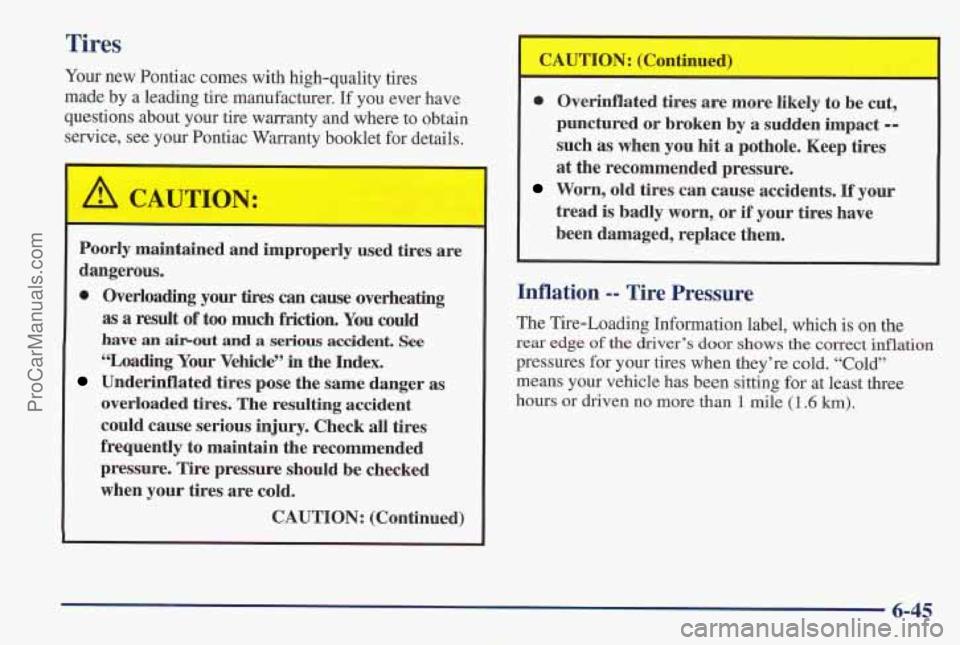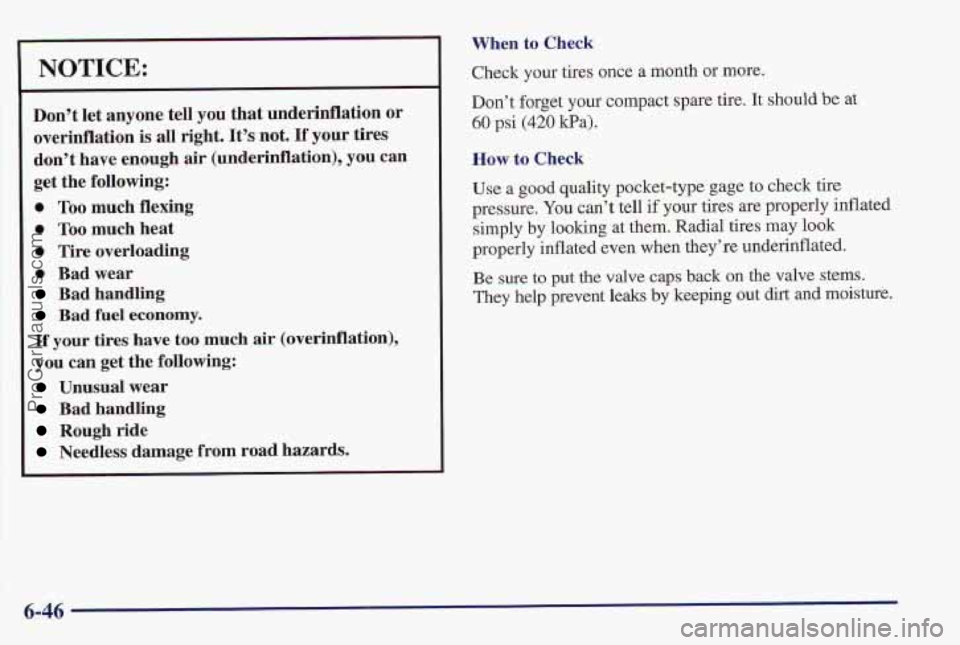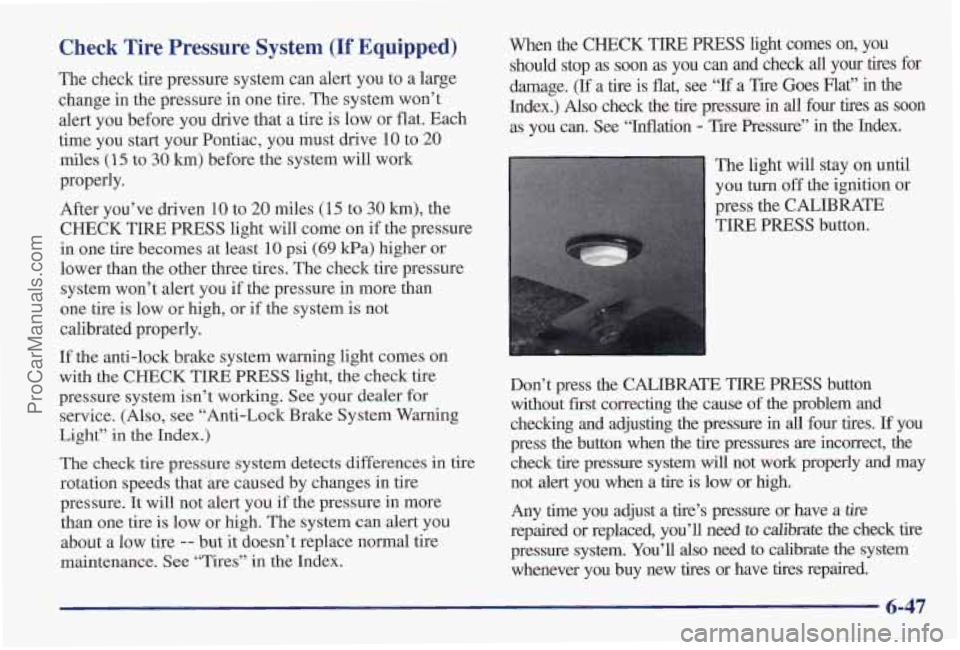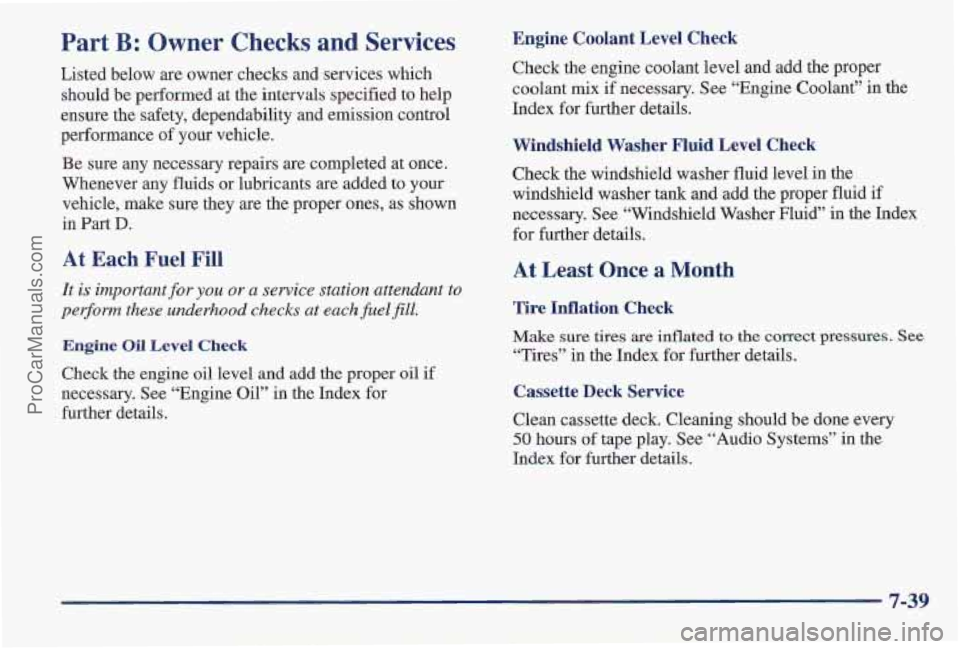1997 PONTIAC PONTIAC tire pressure
[x] Cancel search: tire pressurePage 267 of 419

Storing the Spare Tire and Tools
1
I
Storing a jack, a tire or ‘other equipment in the
passenger compartment
of the vehicle could
cause injury. In a sudden stop or collision, loose
equipmen.t could strike someone. Store all these in the proper place.
The compact spare is for temporary use only. Replace
the compact spare tire with a full-size tire as soon as you
can. See “Compact Spare Tire” in the Index. See the
storage instructions label to replace your compact spare
into your trunk properly.
Be sure to calibrate your check tire pressure system after
you replace your compact
spare tire with a full-sized
one. See “Check Tire Pressure Light” in the Index.
I
1. Retainer
2. Cover
3. Retainer
(Full Size
Spare)
4. Tire
5. Nut
6. Jack
7. Wrench
8. Lock Nut Tool
9. Foam
10. Bolt Screw
11. Extension and
Protector/Guide
5-33
ProCarManuals.com
Page 268 of 419

Compact Spare Tire
Although the compact spare tire was fully inflated
when your vehicle
was new, it can lose air after a time.
Check
the inflation pressure regularly. It should be
60 psi (420 Ha).
After installing the compact spare on your vehicle, you
should stop as soon
as possible and make sure your spare
tire is correctly inflated.
The compact spare is made to
perform well
at speeds up to 65 rnph (105 kdh) for
distances up to
3,000 miles (5 000 krn), so YOU can finish
your trip and have your full-size tire repaired or replaced
where
you want. You must calibrate the Tire Pressure
Monitor after installing
or removing the compact spare.
See “Driver Information Center - Controls and Displays”
in
the Index. Of course, it’s best to replace your spare
with a full-size tire as soon as you can. Your spare
will last longer and be in good shape in case you need
it again.
NOTICE:
When the compact spare is installed, don’t take
your vehicle through an automatic vehicle wash
with guide rails. The compact spare can get
caught
on the rails. That can damage the tire and
wheel, and maybe other parts
of your vehicle.
Don’t use your compact spare on other vehicles.
And don’t mix your compact spare tire or wheel with
other wheels or tires. They won’t fit. Keep your spare
tire and its wheel together.
NOTICE:
Tire chains won’t fit your compact spare. Using
them can damage your vehicle
and can damage
the ‘chains too. Don’t use tire chains on your
compact spare.
5-34
ProCarManuals.com
Page 315 of 419

Tires
Your new Pontiac comes with high-quality tires
made by
a leading tire manufacturer. If you ever have
questions about your tire warranty and where to obtain
service, see your Pontiac Warranty booklet for details.
E
Poorly maintained and improperly used tires are
dangerous.
Overloading your
tires can cause overheating
as a result of too much friction. You could
have
an airout and a serious accident. See
“Loading Your Vehicle” in the Index.
Underinflated tires pose the same danger as
overloaded tires. The resulting accident
could cause serious injury. Check all tires
frequently to maintain the recommended
pressure. Tire pressure should be checked
when your tires are cold.
CAUTION: (Continued)
0 Overinflated tires are more likely to be cut,
punctured or broken by a sudden impact
--
such as when you hit a pothole. Keep tires
at the recommended pressure.
Worn, old tires can cause accidents. If your
tread is badly worn,
or if your tires have
been damaged, replace them.
Inflation -- Tire Pressure
The Tire-Loading Information label, which is on the
rear edge of the driver’s door shows the correct inflation
pressures for your tires when they’re cold. “Cold”
means your vehicle has been sitting for at least three
hours or driven
no more than 1 mile (1.6 km).
6-45
ProCarManuals.com
Page 316 of 419

I NOTICE:
Don't let anyone tell you that underinflation or
overinflation is all right. It's not.
If your tires
don't have enough air (underinflation), you can
get the following:
0 Too much flexing
0 Too much heat
0 Tire overloading
0 Bad wear
Bad handling
Bad fuel economy.
If your tires have too much air (overinflation),
you can get the following:
Unusual wear
Bad handling
Rough ride
Needless damage from road hazards. When
to Check
Check your tires once a month
or more.
Don't forget your compact spare tire. It should
be at
60 psi (420 kPa).
How to Check
Use a good quality pocket-type gage to check tire
pressure. You can't tell if your tires
are properly inflated
simply
by looking at them, Radial tires may look
properly inflated even when they're underinflated.
Be sure to put the valve caps back on the valve stems.
They help prevent leaks
by keeping out dirt and moisture.
6-46
ProCarManuals.com
Page 317 of 419

Check Tire Pressure System (If Equipped)
The check tire pressure system can alert you to a large
change in the pressure in one tire. The system won’t
alert you before you drive that a tire is low or flat. Each
time you start your Pontiac, you must drive
10 to 20
miles (15 to 30 km) before the system will work
properly.
After you’ve driven
10 to 20 miles (15 to 30 km), the
CHECK TIRE PRESS light will come on if the pressure
in o’ne
tire becomes at least 10 psi (69 kPa) higher or
lower than the other three tires. The check tire pressure
system won’t alert you if the pressure in more than
one tire is low or high, or if the system is not
calibrated properly.
If the anti-lock brake system warning light comes on
with the
CHECK TIRE PRESS light, the check tire
pressure system isn’t working. See your dealer for
service. (Also, see “Anti-Lock Brake System Warning
Light” in
the Index.)
The check tire pressure system detects differences in tire
rotation speeds that are caused by changes in tire
pressure. It will not alert you if the pressure in more
than one tire is low or high. The system can alert you
about
a low tire -- but it doesn’t replace normal tire
maintenance. See “Tires” in
the Index. When
the CHECK
TIRE PRESS light comes on, you
should stop as soon
as you can and check all your tires for
darnage. (If a tire
is flat, see “If a Tire Goes Flat” in the
Index.) Also check the tire pressure in all four tires as soon
as you can. See “Inflation - Tire Pressure” in the Index.
The light will stay on until
you turn off the ignition
or
press the CALIBRATE
TIRE
PRESS button.
Don’t press the CALIBRATE TIRE
PRESS button
without first correcting the cause of the problem and
checking and adjusting the pressure in all four tires.
If you
press the button when the tire pressures
are incorrect, the
check tire pressure system will not work properly
and may
not alert you when a tire is low or high.
Any time you adjust a tire’s pressure or have a
tire
repaired or replaced, you’ll need to calibrate the check tire
pressure system. You’ll
also need to calibrate the system
whenever you buy new tires or have
tires repaired.
6-47
ProCarManuals.com
Page 318 of 419

To calibrate the system:
1. Turn the ignition switch to ON.
2. The CALIBRATE TIRE PRESS button is under the
instrument panel, to the right of the steering column.
Press and hold the button for about three seconds.
The
CHECK TIRE PRFSS light will flash three
times and go out.
If the light doesn’t go out after you
press the
CALIBRATE TIRE PRESS button, see
your dealer for service.
3. The system completes the calibration process during
driving. During the first
10 to 20 miles (15 to 30 km)
of driving, the system will not alert you if a tire is
low or high. After
20 to 80 miles (30 to 125 km), the
system will only alert
you about pressure differences
of
12 psi (85 kPa) or more. After 80 miles (125 km)
of driving, the system will alert you if a tire is 8 psi
(55 Pa) different from the other three tires.
Tire Inspection and Rotation
Tires should be rotated every 6,000 to 8,000 miles
(10 000 to 13 000 km). Any time you notice unusual
wear, rotate your tires as soon as possible and check
wheel alignment. Also check for damaged tires or
wheels. See “When
It’s Time for New Tires” and
“Wheel Replacement” later in this section for
more information. The
purpose
of regular rotation is to achieve more
uniform wear for all tires on the vehicle. The first
rotation is the most important. See “Scheduled
Maintenance Services” in the Index for scheduled
rotation intervals.
When rotating your tires, always use
the correct rotation
pattern shown here.
Don’t include the compact spare tire in your tire rotation.
6-48
ProCarManuals.com
Page 319 of 419

After the tires have been rotated, adjust the front and
rear inflation pressures as shown on the Tire-Loading
Information label. Make certain that all wheel nuts
are
properly tightened. See “Wheel Nut Torque” in the Index.
Rust or dirt on
a wheel, or on the parts to which
it is fastened, can make wheel nuts become loose
after
a time. The wheel could come off and cause
an accident. When you change a wheel, remove
any rust or dirt from places where the wheel
attaches to the vehicle.
In an emergency, you can
use a cloth or a paper towel to do this; but be
sure to use a scraper or wire brush later, if you
need to, to get all the rust or dirt off. (See
“Changing
a Flat Tire” in the Index.) When
It’s Time for New Tires
One way
to tell when it’s
time for new tires
is to
check the treadwear
indicators, which will
appear when your tires have
only 1/16 inch (1.6 mm) or
less of tread remaining.
You need a new tire if any of the following statements
are true:
You can see the indicators at three or more places
around the tire.
You can see cord or fabric showing through the
tire’s rubber.
0 The tread or sidewall is cracked, cut or snagged deep
enough to show cord or fabric.
0 The tire has a bump, bulge or split.
The tire has a puncture, cut or other damage that
can’t be repaired well because
of the size or location
of the damage.
ProCarManuals.com
Page 383 of 419

Part B: Owner Checks and Services
Listed below are owner checks and services which
should be performed at the intervals specified to help
ensure the safety, dependability and emission control
performance
of your vehicle.
Be sure any necessary repairs are completed at once.
Whenever any fluids or lubricants are added to your
vehicle, make sure they are the proper ones, as shown
in Part
D.
At Each Fuel Fill
It is important for you or a service station attendant to
perform these underhood checks at each fuel
fill.
Engine Oil Level Check
Check the engine oil level and add the proper oil if
necessary. See “Engine Oil” in the Index for
further details.
Engine Coolant Level Check
Check the engine coolant level and add the proper
coolant mix if necessary. See “Engine Coolant” in the
Index for further details.
Windshield Washer Fluid Level Check
Check the windshield washer fluid level in the windshield washer tank and add the proper fluid if
necessary. See “Windshield Washer Fluid” in
the Index
for further details.
At Least Once a Month
Tire Inflation Check
Make sure tires are inflated to the correct pressures. See
“Tires” in the Index for further details.
Cassette Deck Service
Clean cassette deck. Cleaning should be done every
50 hours of tape play. See “Audio Systems” in the
Index for further details.
7-39
ProCarManuals.com